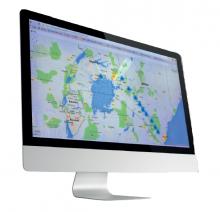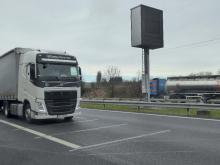Shem Oirere looks at how weigh-in-motion is helping to streamline the trucking industry in Kenya.
Kenya, East Africa’s largest economy, is streamlining trucking operations on its section of the 8,800km Northern Corridor. It is both reducing the number of weighbridges and automating the remaining ones in an effort to improve efficiency and eliminate corruption.The Northern Corridor is a major gateway through Kenya to the landlocked countries of Uganda, Rwanda, Burundi, Democratic Republic of Congo and Sou

Screener lane showing HSWIM loops and cameras at Mariakani weighbridge
Shem Oirere looks at how weigh-in-motion is helping to streamline the trucking industry in Kenya.
Kenya, East Africa’s largest economy, is streamlining trucking operations on its section of the 8,800km Northern Corridor. It is both reducing the number of weighbridges and automating the remaining ones in an effort to improve efficiency and eliminate corruption.The Northern Corridor is a major gateway through Kenya to the landlocked countries of Uganda, Rwanda, Burundi, Democratic Republic of Congo and South Sudan as well as Northern Tanzania. Efforts to streamline the trucking industry are a direct response to pressure exerted by transporters and the East African Community (EAC), a regional organisation of five countries that promote the region’s economic integration.
Some of the challenges are regional in nature such as the different traffic rules and regulations in each of the East African countries and these continue to hinder smooth flow of trucking along the Corridor. There is also an unresolved question enforcing the axle or gross vehicle weight - in Uganda the trucks are weighed based on the axle load, while in Kenya the vehicles are checked for gross vehicle weight (GVW).
In Kenya the maximum GVWs range from 18tonnes for two-axle rigids to 48tonnes for six-axle articulated vehicles and drawbars. The limit on a steering axle is 8tonnes with a 400kg tolerance to allow for load movement during transit, while a three-axle bogie can carry 24tonnes with a 1,200kg tolerance.
7662 Kenya National Highways Authority (KeNHA) says a vehicle with overloaded axle(s) but within the GVW can redistribute its cargo before being reweighed and allowed to continue. Vehicles which cannot redistribute the load to come within the tolerances are fined.
The1816 European Union delegation to Tanzania and EAC say the different requirements for axle load and gross vehicle mass limit is a major impediment to transport efficiency within East African leading to inefficiencies, delays, high cost of transport, court cases and other problems.
Concerns have been raised over unnecessary delays at weighbridges caused by inefficiency and corruption which have been blamed for lost business by both landlocked governments and investors in the trucking industry. The Kenya Transport Association (KTA) says what has been happening at the weighbridges was ‘not acceptable.’
“The traffic jams adversely affect the regional economies because some of the cargo moved by the trucks is meant for manufacturing and the delays have huge costs to economies,” says Jane Njeru, chief executive officer at KTA.
Transporters have previously argued the many weighbridges in Kenya are a distraction from efforts to achieve a smooth flow of truck traffic on the Northern Corridor.
“These are part of the non-tariff barriers that have continued to hinder trade,” said Njeru adding that KTA members incur massive costs in terms of lost trips because of the time wasted at various weighbridges along the Corridor.
Kenya’s Ministry of Trade has been a key player in efforts to eliminate trade glitches on the Northern Corridor. KeNHA says the delays at its seven weighbridges was due to weighing only being carried out on one side of the carriageway “forcing a constant stream of vehicles to cross over from the opposite lane for weighing.”
It issued tenders for the technical upgrade and management of five weighbridge clusters covering nine weigh stations with 11 fixed weighbridges and six mobile weighbridges. SGS Kenya won all the tenders through a competitive bidding process.
So after privatising operations in November 2012 automated systems have been installed at four of the weigh stations: Mariakani, Athi River, Gilgil and Webuye.
Two private operators, SGS Kenya and Avery East Africa jointly operate three weighbridges. These operations have received commendation from transporters who say cases of corruption, where government officials colluded with transporters to let through overloaded trucks, have reduced and efficiency improved.
“The new operators have managed the stations professionally and there is no doubt that this has reduced the incidences of corruption,” said KTA’s Paul Maiyo.
One of the biggest achievements in this ongoing process is the introduction of the High Speed Weighing in Motion systems (HSWIMs). KeNHA’s axle load control manager Muita Ngatia says HSWIMs near weighbridges improve efficiency and ensure vehicles carry the right load to prevent road damage.
“These are located two hundred metres away from the weighbridge. Once a truck’s tyres run on top of the sensor, the computer will automatically indicate to the police manning the checkpoint whether to divert the truck into the weighbridge or the let it pass,” he explains.
SGS Kenya managing director Albert Stockell says: “The HSWIM identifies potentially overloaded trucks while the vehicles are still in motion in the travel or screening lanes. It enables the operator to only weigh vehicles which were identified as possibly overloaded on the accurate static weighbridge scales.”
He believes the venture is the start of a new era for road freight in the region and that the HSWIM technology will “facilitate trade by protecting the road and only weighing possibly overloaded vehicles.”
SGS Kenya selected IRD-PAT Bending Plates WP 1750 HSWIMS manufactured by69 International Road Dynamics. Based on load cell technology, the system can weigh vehicles travelling at between 5km/h and 200km/h and can also be used for traffic monitoring, overload detection, toll applications and data collection.
While Stockell points out that the new technology does not replace conventional static weighbridges, it does reduce the number of vehicles that have to be weighed on the static scale. He says: “Under perfect conditions HSWIM accuracy can be well over 90%, but it is influenced by the road surface, driver behaviour, lane discipline and speed. Therefore HSWIM cannot replace the accuracy of static scales for prosecution purposes, but it is highly effective for screening.”
Trucks driving toward the weighing station will be advised to keep left and use the separate ‘weigh-in-motion lane’ which is separated from the rest of the carriageway by a kerb or median. Compliant trucks can pass through unhindered without having to stop at the weighbridge - saving hours of waiting time per trip. The potentially overweight vehicles are directed to a static weighbridge which will provide high accuracy measurements for enforcement purposes.
Following the installation of the four HSWIMS in September 2013, Stockell says the Northern Corridor has recorded great improvements in flow of cargo traffic and efficiency in truck weighing.
With the HSWIM taking place in the screening lane, the number of vehicles being weighed on the static scale has been be reduced by up to 60% and, depending on how transporters respond, may reduce further. “In addition, it has caused a substantial decrease (estimated at over 60%) in carbon emissions from trucks waiting to be weighed,” says Stockell.
Joseph Kosure, senior assistant director of external trade at the ministry, said modernisation of the weighbridges was pushed to the top of the government’s Northern Corridor priority list following recommendations by an inter-governmental committee.
“It was the wish of the committee that we should progressively move towards a point where once goods are cleared at the port of Mombasa, the next point should the final destination,” he said.
“In the long run we may need to reduce the number of weighbridges such as Mariakani, Mlolongo, Mai Mahiu, Busia and Malaba which cause delays that impact negatively on our economy. Our trade partners in Uganda, Rwanda, South Sudan, Democratic Republic of Congo, Burundi and Central Africa Republic are equally concerned with the delays.”
According to the Northern Corridor Transit Transport Coordination Authority (NCTTCA): “In some countries increased compliance with axle load controls have paid back through reduced maintenance costs and enhanced life of the road and trucks.”
Similar HSWIM systems have been installed at Athi River, Gilgil and Webuye weighbridges but transporters have not been that fast to react to the new reality. Even with the HSWIM to prevent correctly laden trucks being delayed for weighing, at Mariakani an average of 1,700 vehicles are being weighed every day – approximately 47% of the trucks using the road.
SGS Kenya says in the first 10 months of 2013, more than 1.5 million trucks, at an average of 150,000 per month, have been weighed. More than 300,000 vehicles have been warned for being overloaded within the percentage grace/tolerance allowed by the government. At least 8,000 vehicles have been charged for overloading and fines totalling Ksh230 million ($2.6 million) have been issued over that period.
However, the average wait to be weighed has been dramatically reduced and, perhaps more importantly, the journey time along the Northern Corridor with a correctly laden vehicle has been cut by approximately four days.
Kenya, East Africa’s largest economy, is streamlining trucking operations on its section of the 8,800km Northern Corridor. It is both reducing the number of weighbridges and automating the remaining ones in an effort to improve efficiency and eliminate corruption.The Northern Corridor is a major gateway through Kenya to the landlocked countries of Uganda, Rwanda, Burundi, Democratic Republic of Congo and South Sudan as well as Northern Tanzania. Efforts to streamline the trucking industry are a direct response to pressure exerted by transporters and the East African Community (EAC), a regional organisation of five countries that promote the region’s economic integration.
Some of the challenges are regional in nature such as the different traffic rules and regulations in each of the East African countries and these continue to hinder smooth flow of trucking along the Corridor. There is also an unresolved question enforcing the axle or gross vehicle weight - in Uganda the trucks are weighed based on the axle load, while in Kenya the vehicles are checked for gross vehicle weight (GVW).
In Kenya the maximum GVWs range from 18tonnes for two-axle rigids to 48tonnes for six-axle articulated vehicles and drawbars. The limit on a steering axle is 8tonnes with a 400kg tolerance to allow for load movement during transit, while a three-axle bogie can carry 24tonnes with a 1,200kg tolerance.
The
Concerns have been raised over unnecessary delays at weighbridges caused by inefficiency and corruption which have been blamed for lost business by both landlocked governments and investors in the trucking industry. The Kenya Transport Association (KTA) says what has been happening at the weighbridges was ‘not acceptable.’
“The traffic jams adversely affect the regional economies because some of the cargo moved by the trucks is meant for manufacturing and the delays have huge costs to economies,” says Jane Njeru, chief executive officer at KTA.
Transporters have previously argued the many weighbridges in Kenya are a distraction from efforts to achieve a smooth flow of truck traffic on the Northern Corridor.
“These are part of the non-tariff barriers that have continued to hinder trade,” said Njeru adding that KTA members incur massive costs in terms of lost trips because of the time wasted at various weighbridges along the Corridor.
Kenya’s Ministry of Trade has been a key player in efforts to eliminate trade glitches on the Northern Corridor. KeNHA says the delays at its seven weighbridges was due to weighing only being carried out on one side of the carriageway “forcing a constant stream of vehicles to cross over from the opposite lane for weighing.”
It issued tenders for the technical upgrade and management of five weighbridge clusters covering nine weigh stations with 11 fixed weighbridges and six mobile weighbridges. SGS Kenya won all the tenders through a competitive bidding process.
So after privatising operations in November 2012 automated systems have been installed at four of the weigh stations: Mariakani, Athi River, Gilgil and Webuye.
Two private operators, SGS Kenya and Avery East Africa jointly operate three weighbridges. These operations have received commendation from transporters who say cases of corruption, where government officials colluded with transporters to let through overloaded trucks, have reduced and efficiency improved.
“The new operators have managed the stations professionally and there is no doubt that this has reduced the incidences of corruption,” said KTA’s Paul Maiyo.
One of the biggest achievements in this ongoing process is the introduction of the High Speed Weighing in Motion systems (HSWIMs). KeNHA’s axle load control manager Muita Ngatia says HSWIMs near weighbridges improve efficiency and ensure vehicles carry the right load to prevent road damage.
“These are located two hundred metres away from the weighbridge. Once a truck’s tyres run on top of the sensor, the computer will automatically indicate to the police manning the checkpoint whether to divert the truck into the weighbridge or the let it pass,” he explains.
SGS Kenya managing director Albert Stockell says: “The HSWIM identifies potentially overloaded trucks while the vehicles are still in motion in the travel or screening lanes. It enables the operator to only weigh vehicles which were identified as possibly overloaded on the accurate static weighbridge scales.”
He believes the venture is the start of a new era for road freight in the region and that the HSWIM technology will “facilitate trade by protecting the road and only weighing possibly overloaded vehicles.”
SGS Kenya selected IRD-PAT Bending Plates WP 1750 HSWIMS manufactured by
While Stockell points out that the new technology does not replace conventional static weighbridges, it does reduce the number of vehicles that have to be weighed on the static scale. He says: “Under perfect conditions HSWIM accuracy can be well over 90%, but it is influenced by the road surface, driver behaviour, lane discipline and speed. Therefore HSWIM cannot replace the accuracy of static scales for prosecution purposes, but it is highly effective for screening.”
Trucks driving toward the weighing station will be advised to keep left and use the separate ‘weigh-in-motion lane’ which is separated from the rest of the carriageway by a kerb or median. Compliant trucks can pass through unhindered without having to stop at the weighbridge - saving hours of waiting time per trip. The potentially overweight vehicles are directed to a static weighbridge which will provide high accuracy measurements for enforcement purposes.
Following the installation of the four HSWIMS in September 2013, Stockell says the Northern Corridor has recorded great improvements in flow of cargo traffic and efficiency in truck weighing.
With the HSWIM taking place in the screening lane, the number of vehicles being weighed on the static scale has been be reduced by up to 60% and, depending on how transporters respond, may reduce further. “In addition, it has caused a substantial decrease (estimated at over 60%) in carbon emissions from trucks waiting to be weighed,” says Stockell.
Joseph Kosure, senior assistant director of external trade at the ministry, said modernisation of the weighbridges was pushed to the top of the government’s Northern Corridor priority list following recommendations by an inter-governmental committee.
“It was the wish of the committee that we should progressively move towards a point where once goods are cleared at the port of Mombasa, the next point should the final destination,” he said.
“In the long run we may need to reduce the number of weighbridges such as Mariakani, Mlolongo, Mai Mahiu, Busia and Malaba which cause delays that impact negatively on our economy. Our trade partners in Uganda, Rwanda, South Sudan, Democratic Republic of Congo, Burundi and Central Africa Republic are equally concerned with the delays.”
According to the Northern Corridor Transit Transport Coordination Authority (NCTTCA): “In some countries increased compliance with axle load controls have paid back through reduced maintenance costs and enhanced life of the road and trucks.”
Similar HSWIM systems have been installed at Athi River, Gilgil and Webuye weighbridges but transporters have not been that fast to react to the new reality. Even with the HSWIM to prevent correctly laden trucks being delayed for weighing, at Mariakani an average of 1,700 vehicles are being weighed every day – approximately 47% of the trucks using the road.
SGS Kenya says in the first 10 months of 2013, more than 1.5 million trucks, at an average of 150,000 per month, have been weighed. More than 300,000 vehicles have been warned for being overloaded within the percentage grace/tolerance allowed by the government. At least 8,000 vehicles have been charged for overloading and fines totalling Ksh230 million ($2.6 million) have been issued over that period.
However, the average wait to be weighed has been dramatically reduced and, perhaps more importantly, the journey time along the Northern Corridor with a correctly laden vehicle has been cut by approximately four days.








